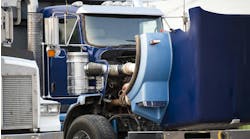Volvo Trucks North America calls its latest VNL "all-new" as it nearly rebuilt the OEM's flagship long-haul truck from a blank slate with efficiency at the forefront.
Specifically, the aerodynamic and powertrain changes not only result in 10% fuel savings over previous versions of the OEM's flagship Class 8 truck, but the tractor should also produce fewer emissions and be easier to maintain.
Since some of the vehicle’s new features may fly under the radar (or under the hood), FleetOwner affiliate Fleet Maintenance traveled to the Volvo Trucks Customer Center in Dublin, Virginia, to get a first-hand walkthrough from Duane Tegels, VTNA product marketing manager. Most (70%) efficiency gains come from a sleeker cab design. These include a wedge-shaped cab with a sloped windshield, a more aerodynamic roofline, and enhancements to the Flow Below aero kits. Furthermore, airflow was redirected to cool the engine. Altogether, Tegels said that these aerodynamic improvements significantly impact efficiency.
“The average truck takes about 325 horsepower to go down the road at approximately 65 miles an hour over rolling hills,” he said, and VTNA’s aerodynamic improvements have “reduced that power requirement by approximately 16 horsepower at 65 miles an hour and 29 horsepower at 75 miles an hour. So what that allows us to do is use different gearing in the rear axle ratio, vastly downspeeding the engine to let it run at lower RPMs. Lower RPMs over the truck’s life cycle increases the overall life expectancy of the components.”
However, aerodynamic changes aren’t the only tweaks impacting the VNL’s ease of maintenance. When it comes to the transmission, VTNA’s engineers “reduced the throw on [the clutch] from 4 to 2 millimeters and also increased the countershaft brake, so it actually slows the countershaft down to do quicker shifting in the transmission,” Tegels said. This change allows the vehicle “to use faster ratios to improve the performance of the vent engine,” reducing overall wear and tear to keep engine components in better shape for longer.
The final significant adjustment the product manager outlines is the new linear exhaust system, which is broken up into separate sections. “Each one of these components can be individually serviced, reducing your overall maintenance cost,” Tegels concluded.




